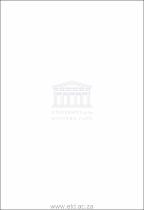| dc.contributor.advisor | Mohamed, Suraya | |
| dc.contributor.author | Garises, Linda Audrey | |
| dc.date.accessioned | 2022-04-26T07:50:38Z | |
| dc.date.available | 2022-04-26T07:50:38Z | |
| dc.date.issued | 2008 | |
| dc.identifier.uri | http://hdl.handle.net/11394/9073 | |
| dc.description | Magister Public Health - MPH | en_US |
| dc.description.abstract | Background: Dental canes and gingivitis are reported to affect 60-90% of school children in most countries (World Health Organization, 2003). Learners in the Swakopmund district of Namibia were examined and it was found that 73% and 89% of them were affected by dental caries and gingivitis respectively (Ministry of Health and Social Services, 2003). This district has implemented an oral health programme at
primary schools with the aim of reducing the prevalence of dental caries and gingivitis. Aim: To compare knowledge, attitudes and behaviour of teachers and learners in response to the school-based oral health programme at four primary schools in Swakopmund district. Study Design: This study is a cross-sectional survey that compared the responses of learners from high participating schools to those from low participating schools. The total sample was 186 participants comprising of 159 learners and 27 teachers. Data Collection: Structured, self-administered questionnaires were used for the teachers whilst learners were interviewed by the researcher and research assistants using
structured questionnaires. Data on knowledge of risk factors for dental caries and gingivitis as well as attitude and behaviour towards prevention of these diseases at school were collected. Data analysis: Data were captured in Microsoft Excel Programme and imported to CDC
Epi Info 2002 version 3.3 for analysis. Prevalence ratio (PR) was used as a preferable measure of effect at 95% confidence interval. Chi-square test was used to assess statistical significance of the proportional differences between high and low participating schools and the cut off point for statistical significance was a p-value < 0.05. 111 Results: Learners from low participating schools were more knowledgeable than learners from high participating schools in most of the knowledge questions and the results were statistically significant. There were positive oral health practices and attitudes reported by the learners with minimal differences between high participating and low participating
schools and consequently the results were not statistically significant. The results for the variables knowledge, behaviour and attitudes for the teachers were not statistically significant. Teachers from both high and low participating schools exhibited high levels of knowledge and positive oral health behaviours and attitudes. However, teachers reported some shortcomings in the programme which included lack of: toothbrushes, parental involvement, time for oral health activities, regular workshops and educational materials. Conclusion: The study revealed that learners and teachers from both high and low participating schools had positive oral health knowledge, attitudes and behaviour towards oral health. However, certain socio-environmental factors which are important determinants of oral health could explain the reasons for low participation in oral health programme by some schools. Therefore the Health Promoting Schools approach is a pragmatic way to promote oral health at schools in Swakopmund district because a Health Promoting School has a healthy public policy that creates a supportive environment for oral health, making healthy choices easier. | en_US |
| dc.language.iso | en | en_US |
| dc.publisher | University of the Western Cape | en_US |
| dc.subject | Dental caries | en_US |
| dc.subject | Gingivitis | en_US |
| dc.subject | Prevalence of oral diseases | en_US |
| dc.subject | Oral diseases risk factors | en_US |
| dc.subject | Prevention of oral diseases | en_US |
| dc.subject | School-based oral health programme | en_US |
| dc.subject | Knowledge and attitude | en_US |
| dc.subject | Health behaviour | en_US |
| dc.subject | Swakopmund | en_US |
| dc.subject | Namibia | en_US |
| dc.title | Comparison of Knowledge, Attitudes and Behaviour of Teachers and Learners Regarding a School-based Oral Health Programme in Swakopmund, Namibia | en_US |
| dc.rights.holder | University of the Western Cape | en_US |

